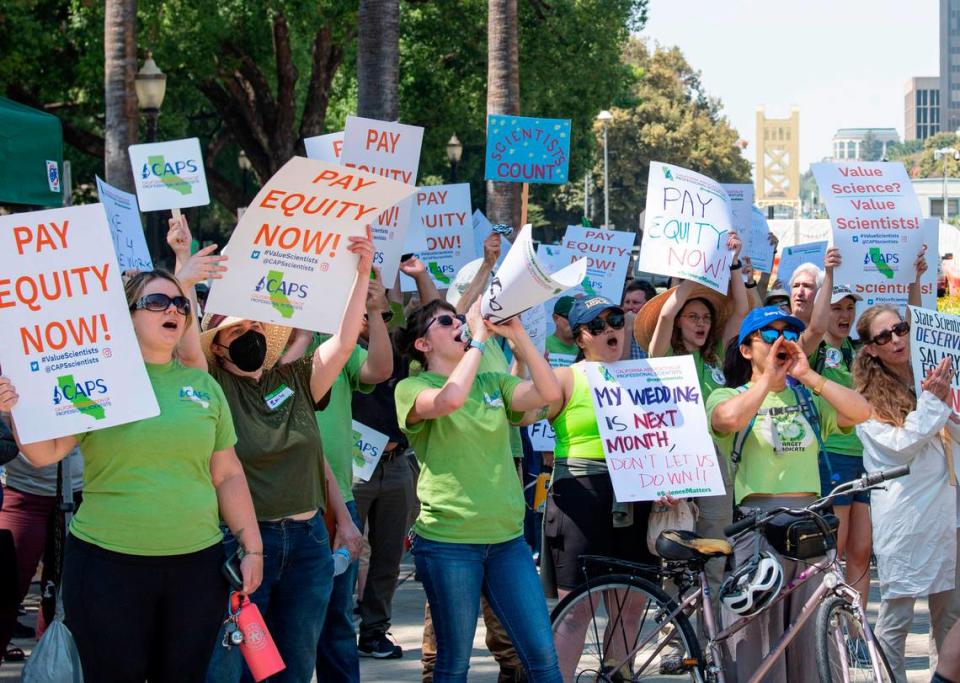California scientist union moves closer to strike after state board approves impasse request
- Oops!Something went wrong.Please try again later.
The union representing state scientists has officially hit a bargaining roadblock with Gov. Gavin Newsom’s administration and could now potentially organize a strike.
California’s Public Employment Relations Board released its ruling Tuesday morning, five days after the California Association of Professional Scientists filed its impasse request. In response, the Department of Human Resources, which represents Newsom at the bargaining table, filed a rebuttal and stated it did not believe the parties were at impasse. CalHR also accused CAPS of bargaining in bad faith.
“The Public Employment Relations Board has determined the existence of an impasse,” wrote PERB senior regional attorney Sheena J. Farro in the three-sentence Tuesday ruling. “The State Mediation and Conciliation Service (SMCS) will assign a mediator who will contact you shortly.”
Jacqueline Tkac, chair of the CAPS bargaining team, said in a Tuesday statement that CalHR’s accusation of bad faith bargaining was “disappointing.”
“We’ve been patient. We’ve worked hard. Now it’s time to take advantage of this additional, legal, commonly used tool to break the logjam,” Tkac said. “If there’s ever been a better example of impasse than talking for 1,288 days without reaching a deal, I don’t know what it could be.”
CalHR spokesperson Camille Travis said that the department does not comment on ongoing negotiations, including impasse procedures.
“The state remains committed to bargaining in good faith to reach a successor agreement with CAPS,” Travis wrote in an emailed statement. “A request for a declaration of impasse is part of the bargaining process established by the Dills Act to help the parties reach agreement.”
Could scientists organize a strike?
The biggest remaining question is whether scientists will choose to stage California’s first strike among state civil service employees. The Ralph C. Dills Act, which granted state workers the right to collectively bargain, requires state employees to work under the terms of their expired contract until a new one can be negotiated. Workers are required to adhere to the “no strike” clause unless PERB determines that the parties have reached impasse.

CAPS has been bargaining with CalHR since March 2020, and their last contract expired in July of that year. The union reached a total tentative agreement with the state last winter, which would’ve granted 4% raises to most of the union and 10% raises to some, but the membership rejected it.
Labor experts say the timeline becomes murky after the mediator is selected.
PERB will likely appoint the mediator within the next few days, said Tim Yeung, a partner with the law firm Sloan Sakai Yeung & Wong. Those mediation talks could last anywhere from a single session of a few hours to multiple hours-long sessions over the course of a month, Yeung said.
“It’s really until the mediator believes that the parties are at a standstill.”
As compared to the state laws that govern labor relations for other public sector employees, such as those in higher education, K-12 schools and local governments, the Dills Act has very few details about the post-impasse timeline. There also isn’t much precedent for impasse among state worker unions, meaning CAPS is venturing into relatively uncharted waters. The last time the state imposed a last, best and final offer was in 2007 after reaching impasse with the California Correctional Peace Officers Association. The union filed unfair labor practice charges against the state for declining to bargain further, but PERB ruled that the state toed the legal line.
Yeung said the unspoken understanding is that the parties need to complete the mediation process in good faith before both sides could play their biggest cards: a strike for the union and the state’s imposition of its “last, best and final offer” on workers.
“If it’s possible to reach an agreement, I would think both sides would be eager to do that,” he said.
Even if the union were to organize a strike, Yeung said he was not convinced that a work stoppage would persuade the state to offer the 30% to 40% raises that the union is seeking. CAPS argues that those raises are what members need to achieve parity between rank-and-file scientists and supervisors, as well as between scientists and their counterparts in the engineering union.
Typically, Yeung said, negotiators net small wins over the course of multiple contracts rather than holding out for a big leap all at once.
“We didn’t get here overnight, so we’re not going to solve it overnight,” he said. “It’s going to take more than one contract.”
The scientists haven’t seen any meaningful raises since their last contract expired. Yeung pointed out that if they decided to strike, workers wouldn’t receive any pay at all. A work stoppage won’t likely force the state to cough up more money, which is the main sticking point for the union.
“I’m not sure how effective a strike would be for them,” Yeung said. “For a lot of the office-type of work that happens at the state, it’s going to be disruptive and the public would be harmed. But I don’t think it would be enough to make the state just cave in.”

